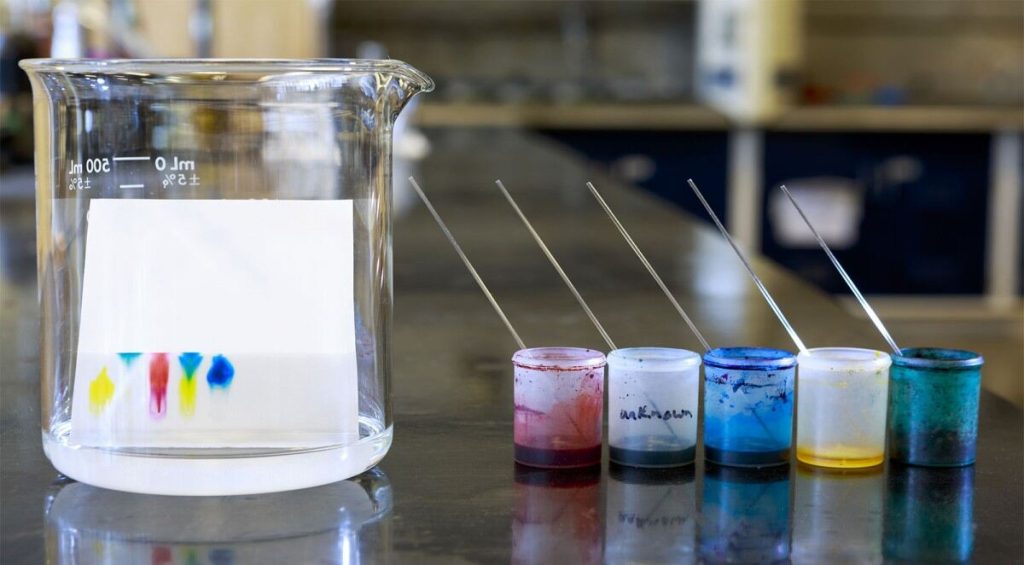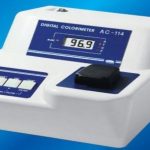Chromatography is derived from Greek terms “chromo= color & gram=bands.”
Hence as the name indicates, in chromatography, there is the formation of colored bands.
These bands are indicative of different components in the sample.
In the Initial stages, it was developed as column chromatography to separate mixtures.
Here into a long vertical column, sample along with a mobile phase was allowed to percolate through a solid stationary phase like sand.
So there were bands of separated compounds at different heights or lengths of the column appearing as colored bands.
Further passage of mobile phase through the column leads to leakage of the components from column bottom into different beakers kept for each band.
With the rise in further requirements in analysis, the mixture molecule separated are identified by using detectors.
Chromatography definition:
“Chromatography is an analytical technique wherein a sample mixture under test is separated into different components.”
This is both a qualitative and quantitative method. The sample gets separated under the influence of a mobile phase (moving phase) over a stationary phase.
These separated components are later identified and also quantified.
Chromatography principle:
Chromatography is based on the principle of separation of compounds into different bands (color graphs) and the identification of those bands.

The preferential separation is done due to differential affinities of compounds towards stationary and mobile phase. After separation of the compounds, they are identified by suitable detection methods.
The differences in affinities arise due to relative adsorption or partition coefficient in between components towards both phases.
Adsorption varies due to the polarity of components towards stationary phase. If both stationary phase and components in sample are polar, the rate of travel for polar component is slow and hence get separated from rest of sample is passed out of the column last. Similarly if both stationary phase and component in the sample are non-polar, then non-polar component comes out last due to slow rate of travel in the column under the influence of mobile phase. So the stationary phase and mobile phase are always opposite. I.e., if the stationary phase is polar, the mobile phase use is non-polar and vice-versa.
Ex: In a sample of a mixture of lipids and proteins. Lipids are non-polar and proteins are polar in nature. Suppose here Sand which is polar in nature is used as stationary phase and non-aqueous solvents like Hexane or Acetone which are non-polar in nature are used as mobile phase. During separation, lipids come out of the column first while proteins come out later due to their higher adsorption to sand stationary phase.
Partition varies due to the solubility of components into different liquids. So here both mobile phase and stationary phase must be liquids. The stationary phase liquid is in the form of a thin layer of film on a hard background in the column. So when a sample mixture having components of differences in solubility in different liquids, of same nature, i.e., either polar or non-polar, they get separated into two liquid phases, i.e., mobile phase and stationary phase based on their partition coefficient in between two liquids.

Ex: Iodine in between water and trichloromethane. Though iodine is soluble in both, it is non-polar in nature and hence is more soluble in trichloromethane than that in water. So most of the iodine separates into it, and very small amount stays in the water.
Chromatography techniques:
There are different techniques in chromatography. For details go through Types of Chromatography But common technical requirements to all the types include
Stationary phase:
The stationary phase is one which stays motionless and allows sample to move over it. This phase used can be solid or liquid. If it is a solid stationary phase, it should have particlesof uniform size and shape. Moreover, their shape should be preferably spherical. If a liquid is used as the stationary phase, the liquid is spread as an uniform layer on the solid background. The chromatography columns are house the stationary phases in all the types of chromatography except in paper and thin layer chromatography as they do not have a column.
The mobile phase:
This is the chromatography liquid and it helps the sample move over the stationary phase. The mobile phase used is a liquid or gas and it should be free of particle matter and other impurities. Technically, the mobile phase should have opposite polarity to that of stationary phase material. I.e., if the stationary phase is of polar in nature, then mobile phase has to be non-polar and vice-versa. In normal phase chromatography, the mobile phase is non-polar in nature while in reverse phase the mobile phase is polar in nature.
Flow rate:
the rate of flow of mobile phase over stationary phase is always kept constant. It should be uniform over the entire time period of experiment for reliable results. High rate will help on faster separation but band can be very closure. If slow rate will be time consuming and also requires more mobile phase.
Temperature:
The temperature of the experimental chamber or chromatography lab is kept uniform. Alteration in temperature can alter the flow rate, the state of mobile phase and also the detector efficiency.
Treatment of sample:
Samples sometimes need to treated for better separation or detection by detector. In such cases the sample is chemically altered before or after the process of separation. This is termed as pre-column or post-column derivation. This is especially followed in gas chromatography for some solvents.
Other techniques like ascending, descending and radial mode of development of chromatograms is followed.
The test sample or standard sample used in the analysis is moistened with the solvent preferably the mobile phase and it should be soft, powder form or homogeneous or pulpy but not hard.
Preparative or analytic technique is employed. For preparative HPLC, the sample quantity is more and is aimed to get pure compound. While in analytic technique samples just analyzed for identification of sample and also determination of its quantity.
Chromatography Uses :
Chromatography is one of the widely used analytic technique in many industries.
· It is used in food industry to check for permissible limits of ingredients.
· It is used in clinical diagnosis to see the levels of the drug in the blood at different time intervals (Kinetics & bio-availability study)
· In scientific research to check the biological substances and their quantity in the extracts.
· In quality control of drugs, in pharmaceutical industries. Once the drug formulation is ready, it is evaluated for quantities of different ingredients. This is done to comply with USP and other pharmacopeial standards.
· It is specifically used to identify and measure the molecules having similar chemistry, optical absorbance, etc.


